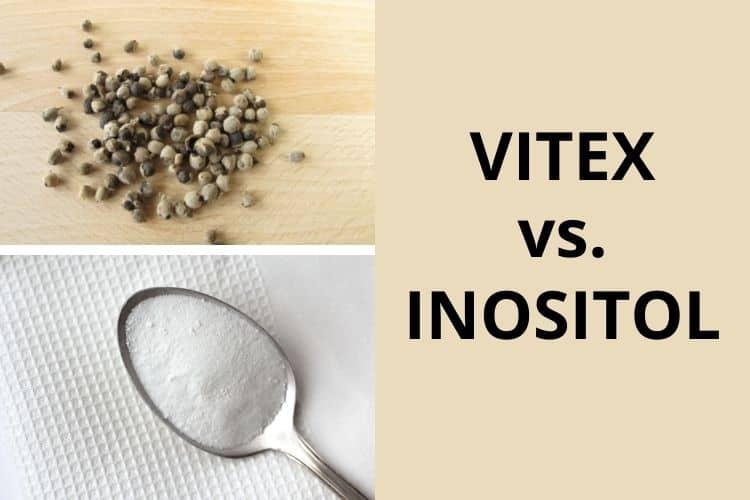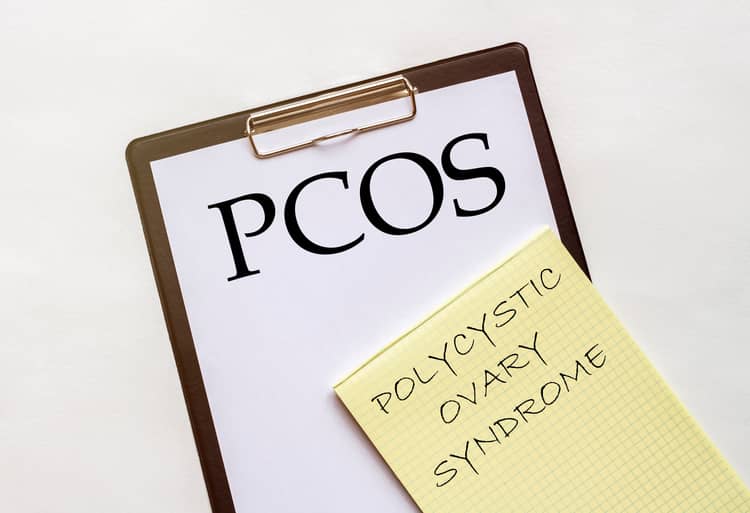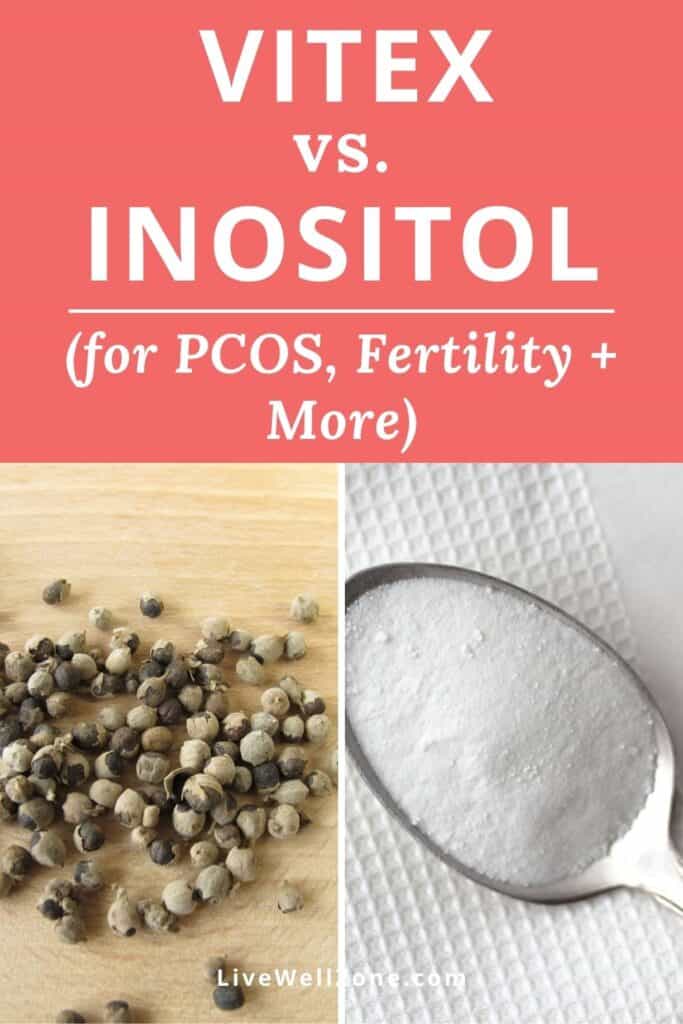
Vitex and inositol are some of the most talked about natural remedies for PCOS, menstrual cycle imbalances and fertility issues.
However, there’s a time and place for each remedy.
So, before you reach for either one of these supplements, read this article on vitex vs inositol to learn more about them.
VITEX VS INOSITOL: MAIN BENEFITS FOR FERTILITY, PCOS AND MORE
| VITEX | INOSITOL | |
|---|---|---|
| increases LH | ✓ | |
| Mildly decreases FSH | ✓ | |
| Lowers elevated prolactin | ✓ | |
| Insulin sensitizer | ✓ | |
| Helps luteal phase defect | ✓ | |
| Supports reproductive health | ✓ | ✓ |
BENEFITS AND CHARACTERISTICS OF VITEX (aka CHASTEBERRY) – Main Sources: 1, 2, 3
- Comes from a shrub that has traditionally been used to treat various women’s health conditions.
- Approved by Germany’s Commission E (similar to the FDA, except they focus only on herbs) for the treatment of menstrual irregularities, breast pain and premenstrual issues (source).
- Acts on the pituitary gland: the pituitary releases FSH (follicle stimulating hormone) and LH (luteinizing hormone). These hormones signal the ovaries, thus regulating follicle growth and the menstrual cycle as a whole. With regular use of vitex, there’s a slight decrease in FSH and an increase in LH.
- Regulates prolactin production: This can be beneficial for missing or irregular cycles since elevated prolactin levels can hinder estrogen production in the ovaries (source).
- Helpful for luteal phase defect (LPD): when LPD is caused by excess prolactin, vitex can be helpful (source). LPD is characterized by a short luteal phase (about 10 days or less) which negatively impacts ovulation.
- Indirectly increases progesterone: vitex’s double action of increasing LH and decreasing FSH contributes to an increase in progesterone. Together with estrogen, sufficient amounts of progesterone are essential for a healthy endometrial lining (which is key for successful implantation).
- Most common side effects: acne, headache, gastrointestinal issues, nausea, menstrual cycle changes, itchy skin and rash.
BENEFITS AND CHARACTERISTICS OF INOSITOL
- Naturally occurring carbohydrate that the body uses for bone health, reproductive health, production of neurotransmitters (like serotonin) and much more.
- Comes in nine different forms, but myo-inositol (MI) and d-chiro-inositol (DCI) are the most relevant for women’s reproductive health.
- The ovaries use more myo-inositol while other parts of the body – like the liver – use more d-chiro-inositol. It’s also worth noting that in the ovaries, myo plays a role in FSH signaling while d-chiro plays a role in testosterone production (4, 5).
- Acts as an insulin sensitizer: since insulin affects everything from ovarian function to blood pressure and triglyceride levels, inositol can lead to a wide range of improvements in one’s health (source).
- Research shows that a 40:1 ratio of myo to d-chiro is ideal for supporting ovulation in PCOS patients (source).
- Most common side effects: available data shows that diarrhea, gas, nausea are the most likely side effects of myo-inositol. As for d-chiro,it is an aromatase inhibitor (aromatase is an enzyme in the body that converts androgens to estrogen). So, if used in excess, it might contribute to elevated androgens (6, 7).
VITEX OR INOSITOL FOR PCOS: WHAT YOU SHOULD KNOW

So far, research has shown that inositol is one of the most beneficial supplements for PCOS.
However, when it comes to vitex, some caution might be necessary before using it for PCOS. Here’s why (8, 9):
- Women with PCOS tend to have elevated levels of LH (luteinizing hormone). This contributes to the high androgen levels and ovulation problems that often go hand-in-hand with PCOS.
- One of vitex’s main actions is to increase LH.
So, based on the above vitex isn’t always the best choice for PCOS. This is not to say that it never helps women with PCOS.
But, to be safe, check with your doctor before adding vitex to your PCOS care plan.
FAQs ABOUT VITEX AND INOSITOL
Which is better inositol or Ovasitol?
Ovasitol is simply the brand name of an inositol supplement. It is one of the most popular and uses a combination of myo and d-chiro inositol in a 40:1 ratio.
How long does inositol take to work?
How quickly inositol works depends on what it’s being used for, as well as the dose used. For example, some research shows that it improves depression within 4 weeks (source). When it comes to reproductive health, Theralogix (the manufacturer of Ovasitol) states that a minimum of three months is required to see improvements in the menstrual cycle or test results (source).
When should I take vitex during my cycle?
In general, natural health practitioners recommend taking vitex after your period and staying away from it while menstruating (10, 11). To be sure that you’re using it correctly, it’s best to consult with a doctor or herbalist.
Can vitex mess up your cycle?
Since vitex does affect both LH and FSH, it can impact the menstrual cycle. In fact, women’s health expert, Dr. Aviva Romm, states that it can either lengthen or shorten the menstrual cycle (source).
While this can occur because vitex simply isn’t for you, it could also occur because you’re taking the wrong dosage.
So, it’s important to work with an herbalist or naturopathic doctor who can guide you in fine tuning the dosage.
How long should I take vitex for?
When using vitex for PMS or heavy cycles, you can use it for 4 to 6 months. For fertility issues accompanied by missing periods, it can be used for 12 to 18 months (source).
Once again, because each person’s needs are different, please work with a professional who can guide you every step of the way.
Can I take inositol and vitex together?
Whether or not you can take both vitex and inositol is something that requires your physician’s input. For example, for some women with PCOS inositol is helpful while vitex can aggravate things. Depending on your symptoms and the results of your hormone testing, your doctor can guide as to whether you can use both.
CONCLUSION
Vitex and inositol provide a variety of benefits when it comes to balancing hormones, regulating the menstrual cycle and supporting fertility.
As powerful as both supplements can be, it’s best to have your dosage customized specifically to your needs.
So, if you’re considering using either one of them, please consult with a healthcare professional.

Related Articles:
Hormone Balancing Foods for PCOS: A Complete Guide (with PDF)
Vitex Vs. Clomid for Pregnancy: Pros & Cons, Success Rates, Side Effects and More
Premama vs Ovasitol: Things to Know Before Using for PCOS, Fertility, Ovulation and More
Maca Fertility Smoothie: Benefits, Best Type To Use and Recipe Tips
5 Natural Alternatives to Clomid
Inositol For PCOS: Pros, Cons and Food Sources
Fertility Diet To Improve Egg Quality Naturally: A Complete Guide with Food List
5 Things You Should Know Before Using Black Cohosh for PCOS And Fertility

